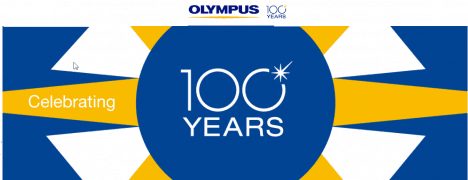FOR 100 YEARS, OLYMPUS HAS DESIGNED SOME OF THE WORLD'S FINEST OPTICAL, MEDICAL AND INSPECTION PRODUCTS. THE OLYMPUS SCIENTIFIC SOLUTIONS GROUP USES CUTTING-EDGE TECHNOLOGIES TO CREATE WORLD-CLASS PRODUCTS FOR INDUSTRIAL AND BIOSCIENCE APPLICATIONS.
From creating solutions that help researchers discover cures for disease, to designing equipment for the inspection of aircraft, bridges, pipelines and other critical infrastructure, we're determined to make significant advances that will keep our customers moving forward for the next 100 years.
In honor of our 100th anniversary, we thought it would be fun to share some interesting facts about how our products have been used over the years. As it turns out, our customers have used them in many interesting ways.
Here are 10 examples.
Let's see what's underneath!
In the 1960s, one of our 2.25 MHz probes was used to measure the thickness of meat and fat on live animals. As it turned out, it really did work - a skilled user could distinguish between layers of skin, fat and muscle based on the different echoes. There was one difficulty to overcome, however: getting the animal to stay still. In order to obtain clear echoes and couple the probe correctly, the animal had to remain practically motionless. Wait, Betty! Hold still!
A canoe, a whale and a probe
A well-known oceanographic institute purchased an EPOCH® fault-finding device and a 500 kHZ probe as part of a study of Atlantic whales. The biologists set off in an inflatable dinghy and attached the probe to the end of a long pole. When a whale came to the surface, they placed the probe on the whale to measure the thickness of its blubber.
OK, that sounds a bit disgusting...
In general, soft tissue transmits ultrasound quite well. We have therefore sold thickness gauges for several biomedical research applications. Animal parts that have been measured include bovine pericardial tissue (used to make heart valves for humans), canine intestines (used for drug studies), rabbit corneas (similar to human corneas) and bovine blood vessels (probably for human health studies).
Thin skin?
Researchers have used our high-frequency immersion probes to measure thin layers of human skin in psoriasis and burn healing studies. Others have already used them to easily measure the speed of sound propagation in bone samples with flat, parallel surfaces, or to measure the thickness of eggshells and lobster shells (in the latter case, as part of a health study on growth). We even sold a system to a Japanese customer who used it to measure the propagation speed and attenuation of waves in melons, as these measurements give an indication of the fruit's ripeness.
Bring me some pasta and cheese!
A food producer purchased an EPOCH device to measure sound propagation velocity through opaque, sealed bags filled with pasta and cheese. The producer used the EPOCH, two 500 Hz V601 probes and a specially designed device to test whether the bags were filled with the correct proportions of macaroni and cheese sauce.
Reinforced candy shells
Thickness gauges were used to measure the thickness uniformity of the outer hard shell of chocolate candies.
Breaking the ice... or not?
The thickness of ice in an indoor rink can be measured using an Olympus corrosion gauge. Pure rink ice is a very fast-transmitting surface for the meter, and low temperatures create damping peaks in the contact probes. A separate 2 MHz D797 transmit-receive probe is therefore used. To measure the thickness of ice in frozen ponds, it is necessary to adjust the grain size and suppression, as bubbles and cracks in the ice reflect the sound waves and prevent them from reaching the lower limit of the ice.
Fantastic for geological research
Researchers have purchased EPOCH instruments to measure sound propagation velocity in rock, compacted soil and glacier ice, as well as in other geological samples. Tests are carried out at low frequencies (500 kHz and below) on prepared samples with flat, parallel sides. Modulus of elasticity can often be calculated by adding a direct transverse wave transmission test to obtain the propagation velocity of transverse waves.
Touching wood
Wood applications are not widespread, as this is a specialized and restricted niche. But as with geological samples, it is generally possible to carry out tests at low frequencies (50 kHz to 250 kHz) and in direct transmission using an EPOCH device or transceiver. Rot can be detected in marine piles and telephone poles by detecting changes in sound propagation velocity with direct wave transmission. Reflective inspection is not possible in wood, but musical instrument manufacturers use Magna-Mike® devices to measure thickness.
Space: the final frontier
IPLEX turns its gaze to space:
The IPLEX MX was one of the first battery-powered videoscopes, making it a highly advanced device for its time. In 2005, an IPLEX MX was modified so that it could be integrated into an astronaut's spacesuit for use in weightlessness during extravehicular activity. A few years later, the more powerful IPLEX SA videoscope was modified for the same purpose. Neither of these videoscopes eventually made it into space. More recently, in 2017, the IPLEX FX was used to refurbish the model of the spaceship Enterprise (the same one used in a famous 1960s TV show), on display at the Smithsonian Institution's National Air and Space Museum. The use of this videoscope proved essential for understanding the construction of the model and minimizing any damage that might occur during renovation.
EPOCH 6LT reaches the stratosphere:
On a dusty road in Bishop, California, at the foot of the Sierra Nevada mountains, the EPOCH 6LT fault-finding device was attached to a high-altitude weather balloon and sent into the stratosphere. A video camera was also attached to the balloon to capture all the action (watch the video here). We had no idea whether the fault detector would survive the trip or not. In just under two hours, the balloon reached its maximum altitude of 36,985 meters, floated for a while, then burst. A small parachute deployed, slowing the EPOCH 6LT's fall until it landed in a remote, rugged area. Three days later, the fault-finding device was found intact. You could say it was an "extreme" drop test!
XRD technology lands on Mars:
The technology behind Olympus' X-ray diffraction (XRD) instruments was first developed for the analysis of Martian soil aboard the Curiosity spacecraft. When XRD technology is used, X-rays are passed through a powdered soil sample to determine the minerals it contains. If the minerals have a crystalline structure, the XRD device analyzes their diffraction patterns. This technology helps scientists to understand the nature of the minerals in the Martian landscape and its geological history.
WWW.OLYMPUS-IMS.COM










 Media kit
Media kit









